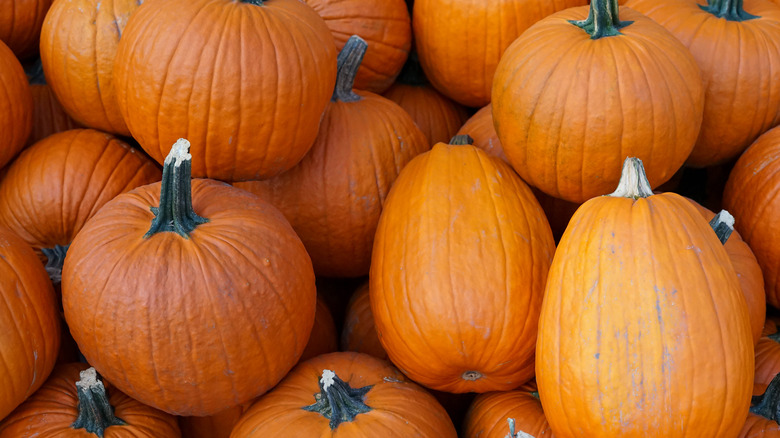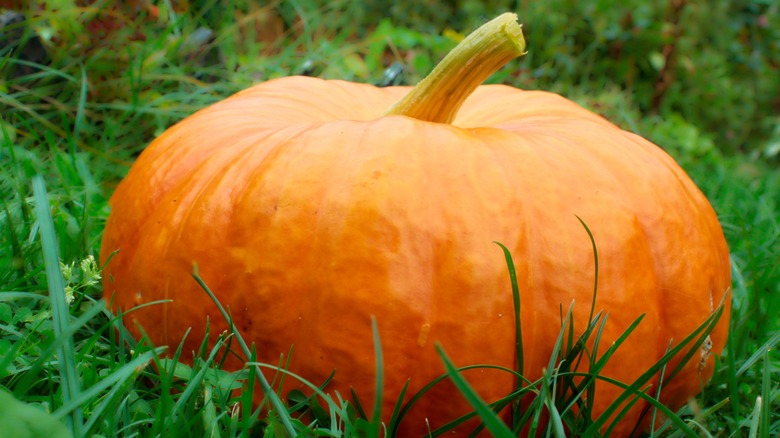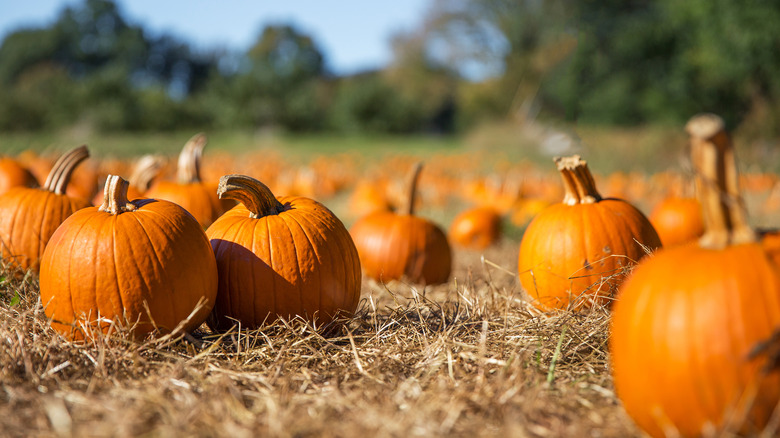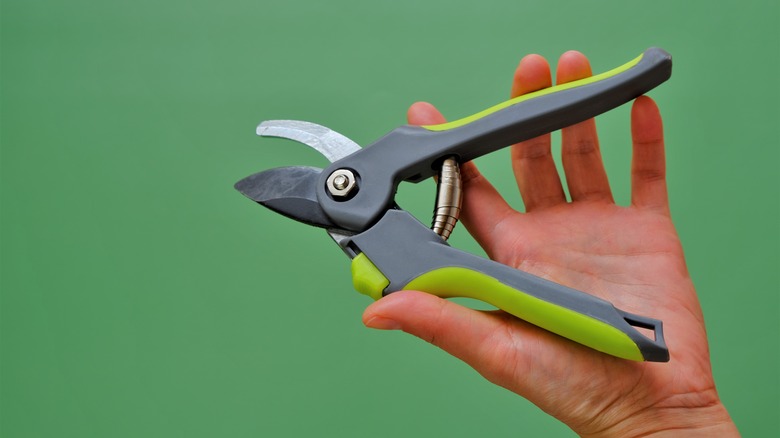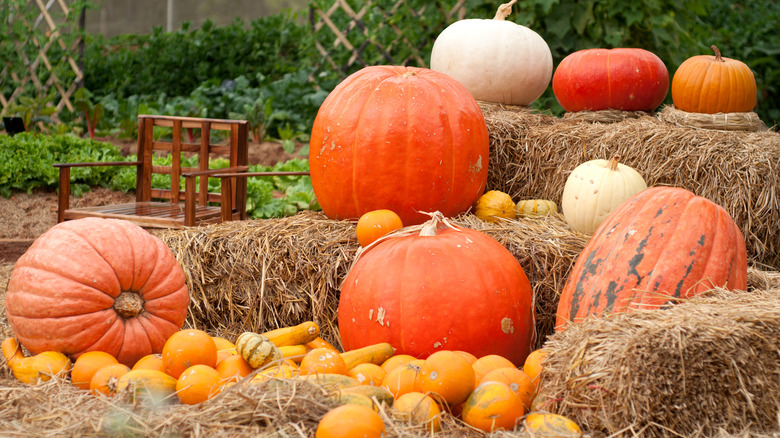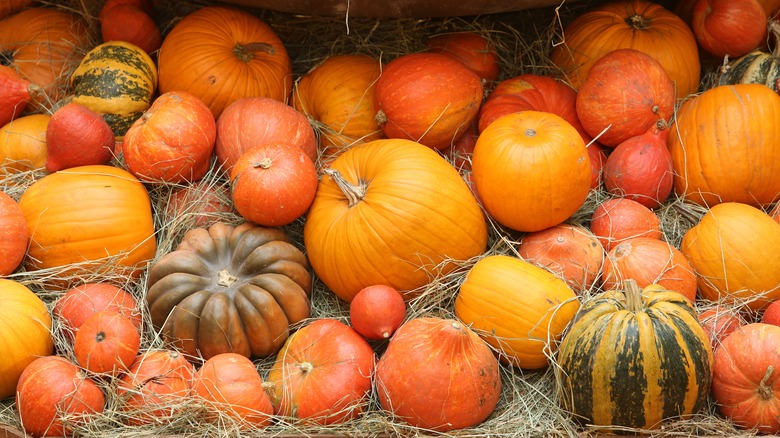5 Tips For Harvesting Your Pumpkins This Fall
If you sowed pumpkin seeds in the spring or summer, odds are the fall season will bring lots of gorgeous, bright orange pumpkin harvests. Pumpkins are one of the most popular and profitable crops in the United States, according to the University of Illinois Extension, with over 1.1 billion pounds of pumpkins produced in 2008 — a total value of $141 million. Whether you're going to use them to create cute or spooky jack-o'-lanterns, delicious pumpkin pies or soups, or decorate your porch, pumpkins are a staple of the fall season.
Pumpkins are a pretty intense crop to harvest, though, especially when compared to other popular homegrown crops like tomatoes, cucumbers, or peppers. You don't want to harvest them too early, but you don't want to wait too long into the fall season. They're also quite heavy, and their stems can be prickly and sharp. Knowing the proper proceedings and precautions for harvesting is vital to ensure a successful pumpkin crop yield.
1. Wait until they're ripe
One of the most important parts of harvesting pumpkins is making sure they're ripe. While there's nothing wrong with unripe pumpkins, they won't be nearly as flavorful as a perfectly ripe, orange pumpkin. On the other hand, if you wait too long, they may begin to rot.
Luckily, there are quite a few signs that can help you determine when your pumpkin is at peak ripeness. To begin, a ripe pumpkin will turn a gorgeous, bright shade of orange, per Homestead Acres. If you're growing a white or other colored variety, wait until it's the brightest shade of that color.
Next, look at the stem it's growing from. Young pumpkins have soft and somewhat fleshy stems, whereas mature and ripe pumpkins have dried-out, hard stems. They also tend to be dark brown or yellow, whereas unripe stems are a greenish-yellow shade. Give your pumpkin a good smack on the side — a ripe pumpkin will sound hollow. Last, tap on the skin. Ripe pumpkins have hard, but not impenetrable, skin.
2. Avoid frost or freezing temperatures
Another crucial aspect of a successful fall pumpkin harvest is making sure the weather and timing are both right. Frost is one of the most detrimental elements pumpkins can be exposed to. According to Michigan State University Extension, this is because once a pumpkin freezes and then thaws, it will begin to decompose. This makes curing a pumpkin that's been frozen impossible.
That doesn't mean you have to harvest unripe pumpkins if there's a threat of frost. Instead, grab a blanket, tarp, or newspaper — anything that can be laid over the top of your pumpkin patch and weighed down. If frost is forecasted, immediately cover up your pumpkin crops. The only exception to this is if it's going to get colder than 32 degrees Fahrenheit, in which case it's better to harvest unripe pumpkins. As for the day of picking your pumpkins, try to choose a day without any rain or wind; pumpkins are already heavy enough without extreme weather.
3. Use proper techniques to harvest
Once your pumpkins are ripe and the weather is right, it's time to actually harvest the orange fall fruit. You should make sure to take necessary precautions before heading out into your pumpkin patch, though. For one, you need to make sure you're dressed properly. As Harvest to Table explains, pumpkin vines are a little spikey. Layer up with a long-sleeved shirt, long pants, and thick gardening gloves.
Next, get your gardening shears ready. Make sure you have a larger, heavier-duty pair of shears since pumpkin stems are quite thick. Take care to clean and disinfect them, too. Identify your ripe pumpkin, and grab it by the stem. Cut the stem close to the pumpkin, but leave at least 3 inches attached — this will help stave off infestation or disease. Always carry or move pumpkins by the bottom so that the stem doesn't snap off.
4. Cure them
Healthy pumpkin vines will yield a lot of fruit — likely more than you know what to do with for the entirety of fall. This is why knowing how to properly cure and store your pumpkins is so important. According to Back Garden, curing simply refers to the pumpkin skin hardening and the fruit getting as ripe and sweet as possible. Curing also helps heal any nicks or bruising on the skin, and ultimately keeps the plant from decaying a little longer.
Begin by giving your ripe and harvested pumpkins a good wash with simple dish soap and water. If there's any lingering disease or bugs on the skin, they may seep farther into the fruit during the curing process. Next, find a warm, dry, and sunny place to cure them. Ideally, the temperatures should be between 80 to 85 degrees Fahrenheit. This may be hard to achieve in the fall, so consider investing in a grow light. Once they're cured, you can keep them in a dry, cool place, or cut them up and freeze them.
5. Don't waste excess pumpkins
Even with curing, there's still a strong possibility that you may have lots of leftover pumpkins and nothing to do with them. If that's the case, don't toss them out — there are plenty of things you can do with excess pumpkins. According to the Pennsylvania Horticultural Society, pumpkins naturally contain a lot of nitrogen, which is a vital element for your garden's health. Throw your leftover pumpkins in a compost bin, where they'll turn into a nutrient-rich fertilizer for the following spring.
You could also leave your pumpkins in the field as the temperatures get colder. Wild animals like deer, squirrels, and birds will readily eat your leftovers — just be sure they have access to your garden. You could also cut them up and set them out for your local wildlife so the pumpkins don't rot in your garden. Finally, there are a variety of ways to prepare pumpkin, including baking the seeds, roasting the fruit, turning it into soups or dessert, and many, many more options.
